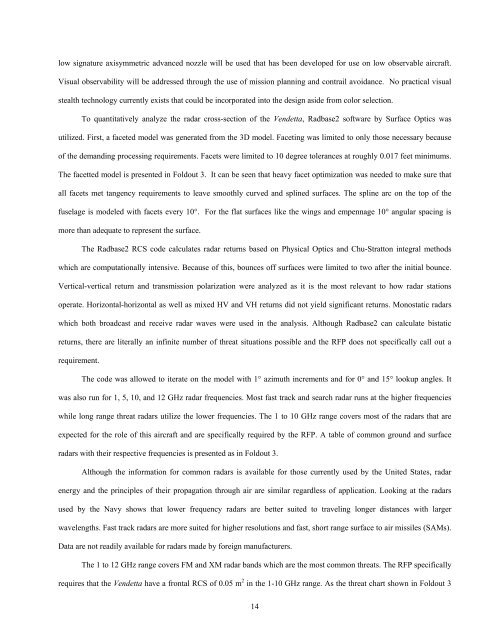Vendetta Final Proposal Part 1 (3.4 MB) - Cal Poly
Vendetta Final Proposal Part 1 (3.4 MB) - Cal Poly
Vendetta Final Proposal Part 1 (3.4 MB) - Cal Poly
- No tags were found...
You also want an ePaper? Increase the reach of your titles
YUMPU automatically turns print PDFs into web optimized ePapers that Google loves.
low signature axisymmetric advanced nozzle will be used that has been developed for use on low observable aircraft.Visual observability will be addressed through the use of mission planning and contrail avoidance. No practical visualstealth technology currently exists that could be incorporated into the design aside from color selection.To quantitatively analyze the radar cross-section of the <strong>Vendetta</strong>, Radbase2 software by Surface Optics wasutilized. First, a faceted model was generated from the 3D model. Faceting was limited to only those necessary becauseof the demanding processing requirements. Facets were limited to 10 degree tolerances at roughly 0.017 feet minimums.The facetted model is presented in Foldout 3. It can be seen that heavy facet optimization was needed to make sure thatall facets met tangency requirements to leave smoothly curved and splined surfaces. The spline arc on the top of thefuselage is modeled with facets every 10°. For the flat surfaces like the wings and empennage 10° angular spacing ismore than adequate to represent the surface.The Radbase2 RCS code calculates radar returns based on Physical Optics and Chu-Stratton integral methodswhich are computationally intensive. Because of this, bounces off surfaces were limited to two after the initial bounce.Vertical-vertical return and transmission polarization were analyzed as it is the most relevant to how radar stationsoperate. Horizontal-horizontal as well as mixed HV and VH returns did not yield significant returns. Monostatic radarswhich both broadcast and receive radar waves were used in the analysis. Although Radbase2 can calculate bistaticreturns, there are literally an infinite number of threat situations possible and the RFP does not specifically call out arequirement.The code was allowed to iterate on the model with 1° azimuth increments and for 0° and 15° lookup angles. Itwas also run for 1, 5, 10, and 12 GHz radar frequencies. Most fast track and search radar runs at the higher frequencieswhile long range threat radars utilize the lower frequencies. The 1 to 10 GHz range covers most of the radars that areexpected for the role of this aircraft and are specifically required by the RFP. A table of common ground and surfaceradars with their respective frequencies is presented as in Foldout 3.Although the information for common radars is available for those currently used by the United States, radarenergy and the principles of their propagation through air are similar regardless of application. Looking at the radarsused by the Navy shows that lower frequency radars are better suited to traveling longer distances with largerwavelengths. Fast track radars are more suited for higher resolutions and fast, short range surface to air missiles (SAMs).Data are not readily available for radars made by foreign manufacturers.The 1 to 12 GHz range covers FM and XM radar bands which are the most common threats. The RFP specificallyrequires that the <strong>Vendetta</strong> have a frontal RCS of 0.05 m 2 in the 1-10 GHz range. As the threat chart shown in Foldout 314













